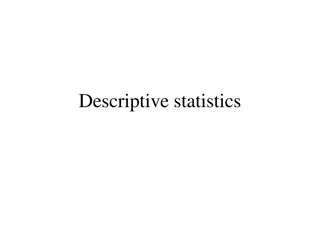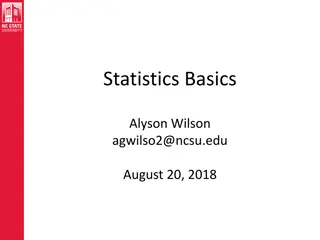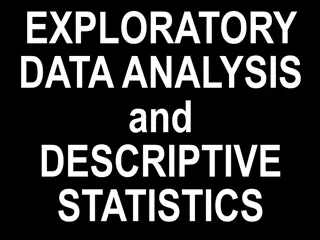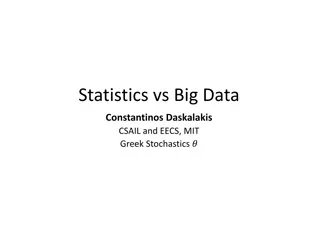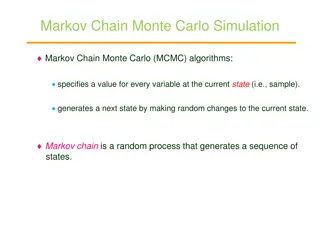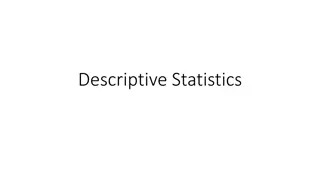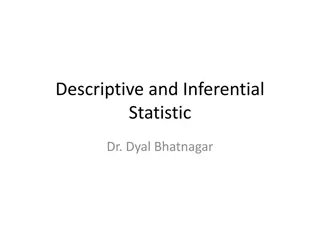Descriptive Statistics and Distributions in QM222 Fall 2017
In this QM222 class, explore descriptive statistics, distributions, and data characteristics. Learn how to analyze data sets, measure variables' middle and spread, and understand different measures based on variable distributions. Discover the significance of Excel in data analysis and its application in interpreting data characteristics. Engage in real-world scenario analysis by surveying company data from various countries. Decode numerical and categorical variables, learn about data types, and identify the dataset type. Enhance your statistical knowledge with practical examples and exercises.
Download Presentation

Please find below an Image/Link to download the presentation.
The content on the website is provided AS IS for your information and personal use only. It may not be sold, licensed, or shared on other websites without obtaining consent from the author.If you encounter any issues during the download, it is possible that the publisher has removed the file from their server.
You are allowed to download the files provided on this website for personal or commercial use, subject to the condition that they are used lawfully. All files are the property of their respective owners.
The content on the website is provided AS IS for your information and personal use only. It may not be sold, licensed, or shared on other websites without obtaining consent from the author.
E N D
Presentation Transcript
QM222 Class 3 Section A1 QM222 Class 3 Section A1 Descriptive Statistics and Distributions Descriptive Statistics and Distributions Where you sit will be your permanent KCB seat Name cards? QM222 Fall 2017 Section A1 1
Some to Some to- -dos Sign up for an appointment (see signup, Sept 20 is the last day) dos https://docs.google.com/a/bu.edu/spreadsheets/d/188IrHsjGhE758eIQ1Jcru-1WGKFmJJYrmD1ppcdcMhY/edit?usp=sharing Many of you have not yet signed up. If you just want to shoot around ideas, I have office hours today 2:15-3:15. Or make an appointment at another time. QM222 Fall 2017 Section A1 2
Some to Some to- -dos Excel Checklist: Do by the end of next week (Sept. 15) Go to our TA s office hours or any other ones and do/learn an Excel checklist about using Excel for formulas Checklist at: http://sites.bu.edu/qm222projectcourse. Click on tab: QM222 Project Course General dos QM222 TA Office Hours in Room 206A (off Undergrad Lounge) Wednes 9-10am 9-10am Project Section A1 Tuesdays Wednes Fridays Sundays Thursdays Fridays 9-10am 10- 11am 11- 12pm 10-11am 10:45- 11:45am 11:45- 12:45pm 12:45-1:30pm 1:30-2:30pm Roland 2:30-4pm 4-5pm 5-6pm 6-7pm 10-11amLexi Klein Shogo 11-12pmLexi Klein James James Shogo Y 12-1pmCristiane 1-2pmCristiane 2-3pmSanya Seth 3-4pmSanya Seth 4-5pmNick Lord 5-6pmRachel Mann 12-1pm 1-2pm 2-3pm Rachel Nick Lord Ata` Ata Maciej Maciej Roland QM222 Fall 2017 Section A1 3
Todays Objectives Today s Objectives Checking your knowledge: Data sets and data characteristics Descriptive statistics and Excel on a single variable (QM221 review): Measuring a variable s middle How the difference between these measures depend on the distributions of the variable What we learn from each different measure Measuring a variable s spread How the difference between these measures depend on the distributions of the variable What we learn from each different measure QM222 Fall 2017 Section A1 4
A survey of companies in various different A survey of companies in various different countries: countries: 5-year sales change -0.6620443 0.3003899 0.7102566 1.539853 -0.1417196 -0.2546803 0.1707842 1.361145 0.2348493 0.4187952 0.3203718 log of num employees country uk uk uk uk uk uk uk uk uk uk uk uk uk uk uk public? ID code 0 0 1 1 0 0 1 1 0 0 0 0 0 0 0 6.663133 6.791222 8.056109 6.120297 5.273 5.459586 8.941415 6.951772 7.252762 6.510258 6.51323 5.209486 4.736198 5.236442 8.518393 4159 4151 4149 4148 4147 4109 4106 4091 4082 4038 4023 4021 4020 4019 4018 1. What does an observation in this dataset represent? 2. Which variables in this data set are numerical? 3. Which variables in this data set are categorical? 4. What kind of dataset is this:? A. Cross-section B. Time-series C. Cross section-Time series D. Panel/Longitudinal 0.07127 -0.1238539 -0.2245746 0.2948269 QM222 Fall 2017 Section A1 5
What if we redid this survey every year for 8 years What if we redid this survey every year for 8 years (and had a new variable year?) Then which (and had a new variable year?) Then which answers would change? answers would change? 5-year sales change employees public? ID code uk -0.6620443 6.663133 uk 0.3003899 6.791222 uk 0.7102566 8.056109 uk 1.539853 6.120297 uk -0.1417196 5.273 uk -0.2546803 5.459586 uk 0.1707842 8.941415 uk 1.361145 6.951772 uk 0.2348493 7.252762 uk 0.4187952 6.510258 uk 0.3203718 6.51323 uk 0.07127 5.209486 uk -0.1238539 4.736198 uk -0.2245746 5.236442 uk 0.2948269 8.518393 A. Cross-section B. Time-series C. Cross section-Time series D. Panel/Longitudinal log of num country 0 0 1 1 0 0 1 1 0 0 0 0 0 0 0 4159 4151 4149 4148 4147 4109 4106 4091 4082 4038 4023 4021 4020 4019 4018 1. What does an observation in this dataset represent? 2. Which variables in this data set are numerical? 3. Which variables in this data set are categorical? 4. What kind of dataset is this:? QM222 Fall 2017 Section A1 6
Todays Objectives Today s Objectives Checking your knowledge: Data sets and data characteristics Descriptive statistics and Excel on a single variable (QM221 review): Measuring a variable s middle How the difference between these measures depend on the distributions of the variable What we learn from each different measure Measuring a variable s spread How the difference between these measures depend on the distributions of the variable What we learn from each different measure QM222 Fall 2017 Section A1 7
Measuring the middle Measuring the middle Xi N N X = Mean i Add up all the values and dividing by the number of observations Median Half the observations are greater than the median, half the observations are smaller than the median. QM222 Fall 2017 Section A1 8
Getting these statistics in Excel Getting these statistics in Excel (for a variable with data in cells a2:a64) (for a variable with data in cells a2:a64) Mean: =average(a2:a64) Median: =median(a2:a64) QM222 Fall 2017 Section A1 9
Now lets think about these descriptive Now let s think about these descriptive statistics: Mean v. Median statistics: Mean v. Median Are they always equal? When and when are they not? They are not equal when the probability distributions are the same to the right and left of the median. Let s first see this with an example. QM222 Fall 2017 Section A1 10
When do people arrive at a party? When do people arrive at a party? (Note that this is a sideways histogram, showing the percent from smallest (Note that this is a sideways histogram, showing the percent from smallest to largest value) to largest value) When do you think it is best to arrive at a party? What do you think is larger the median or the mean? QM222 Fall 2017 Sections E1 & H1 11
When do people arrive at a party? When do people arrive at a party? Mean arrival: 67 minutes late Median arrival: 45 minutes late QM222 Fall 2017 Sections E1 & H1 12
Percentiles and distribution Percentiles and distribution That bar graph of arrival times gives you the whole distribution It puts it in ranges: We call that a histogram Histograms rotate that graph so bars are vertical: The histogram of a variable X has the values of X on the X-axis. It has the frequency/relative frequency (percentage) for each class/category on the Y-axis. You can make histograms in Excel or Stata QM222 Fall 2017 Section A1 13
Percentiles and distribution Percentiles and distribution Why does this distribution give us a different mean and median? Because the probability distributions are the same to the right and left of the median: It is not symmetric. QM222 Fall 2017 Section A1 14
Here are some kinds of distributions. Here are some kinds of distributions. (There are many other possible types of distributions) (There are many other possible types of distributions) Note which are symmetric and which aren t Note which are symmetric and which aren t
A very important case skewed case where mean A very important case skewed case where mean and median are different and median are different To foreshadow what is coming later in lecture it helps to look at the distribution of income The mean was $76,836. QM222 Fall 2016 Section D1 16
Lets think about Measures of the Spread Let s think about Measures of the Spread Range: Max Min Pro s: Simple Con s: Can be highly affected by ONE unusual observations. Standard deviation Measures how far is the data spread out around the mean 2 1 n = . . ( ) Std Dev X X i 1 n i 2) . . ( Std Dev Average of deviations from average Pros: A single measure based on all observations Cons: Not as intuitive to some people. QM222 Fall 2017 Sections E1 & H1 17
Low and high standard deviations Low and high standard deviations The larger the SD, the more spread out the data are. Here, we show a smooth (continuous) distribution.
For Discussion For Discussion If I give you the bad news that you got 65 in the exam and the class average was 78, in which situation would you rather be: Std deviation of the class was 5 Std deviation of the class was 13 Or are you indifferent?
Getting these statistics in Excel Getting these statistics in Excel (for a variable with data in cells a2:a64) (for a variable with data in cells a2:a64) Range: =max(a2:a64 ) min (a2:a64) Standard deviation: =stdev(a2:a64) or =stdev.s(a2:a64) both are for a sample QM222 Fall 2017 Section A1 20
But giving the value of a variable at various But giving the value of a variable at various percentiles can also be used as a measure percentiles can also be used as a measure This is the distribution of all 2000 observations of 25 year- olds salaries. We can measure the spread by looking at the income at pairs of percentiles. 50% of people are between the 25th and the 75th percentiles. 80% of people are between the 10th and the 90th percentiles. We can calculate income at different percentiles. Histogram of 25 year-old with Business Majors 0.3 0.25 0.2 proportion 0.15 0.1 0.05 0 0 25000 50000 75000 100000125000150000175000200000 More Earnings Which is larger here, the mean or the median? Why? QM222 Fall 2017 Section A1 21
Getting percentiles in Excel Getting percentiles in Excel (for a variable with data in cells a2:a64) (for a variable with data in cells a2:a64) 25th and 75th percentiles: =percentile(a2:a64,0.25) gives the value at the 25th percentile of the data set =percentile(a2:a64,0.75) gives the value at the 75th percentile of the data set. QM222 Fall 2017 Section A1 22
Growing inequality has increased income at the higher percentiles, but not the median wage much. What has happened to the MEAN? QM222 Fall 2017 Sections E1 & H1 23
The top 1% are getting increasingly rich The top 1% are getting increasingly rich Source: March 2012 Update to Piketty and Saez (2003) QM222 Fall 2017 Section A1 24
The most used distribution? The most used distribution? The normal The normal distribution distribution QM222 Fall 2016 Section D1 25
Normal Distribution Normal Distribution A Normal distribution looks like a symmetric bell curve Symmetric means that the right side of the mean is a mirror image of the left side Bell curves look like a bell. Notation here: is the mean, and is the standard deviation Approximately 68% (or around 2/3rds) of the observations are within one standard deviation of the mean. Approximately 95% of the observations are within two standard deviations of the mean. QM222 Fall 2016 Section D1 26
Example of normal distributions Example of normal distributions Weather : Climate change by graphs Weather : Climate change by graphs This plot shows temperature patterns in the Northern Hemisphere for each decade from the 1950s through the 2000s. What is happening to the mean of the distribution over time? What is happening to the standard deviation of the distribution? What does this suggest about climate change? QM222 Fall 2016 Section D1 27
Today we Today we Learned when we might use mean and when we might use median Learned about the usefulness of percentiles Reviewed idea of (probability) distributions Learned more on distributions Symmetric v. skewed Bell shaped v. uniform v. other Normal distributions and their characteristics QM222 Fall 2017 Section A1 28



